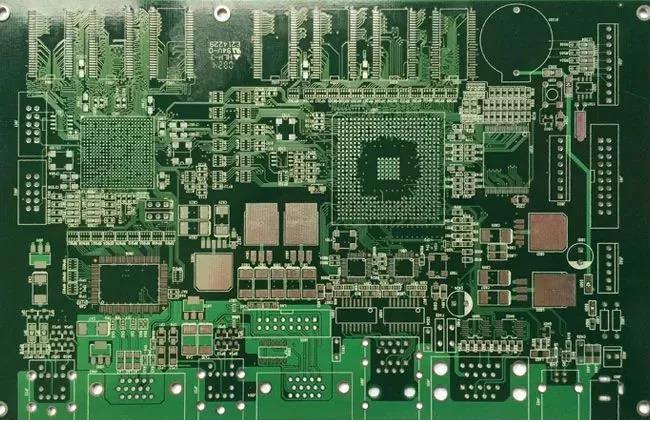Definition of PCB high frequency board
The high-frequency board of the circuit board factory refers to the special circuit board with higher electromagnetic frequency. It is used for high frequency (frequency greater than 300MHZ or wavelength less than 1 meter) and microwave (frequency greater than 3GHZ or wavelength less than 0.1 meter). Microwave substrate copper clad laminates are circuit boards produced by using part of the process of ordinary rigid circuit board manufacturing methods or using special processing methods. Generally speaking, a high-frequency board can be defined as a circuit board with a frequency above 1GHz.
With the rapid development of science and technology, more and more equipment is designed for applications in the microwave frequency band (>1GHZ) and even in the millimeter wave field (30GHZ). This also means that the frequency is getting higher and higher, and the circuit board is The requirements for materials are getting higher and higher. For example, the substrate material needs to have excellent electrical properties, good chemical stability, and the loss on the substrate with the increase of the power signal frequency is very small, so the importance of the high-frequency board is highlighted.
PCB high frequency board application field
Mobile communication products;
Power amplifier, low noise amplifier, etc.;

Passive components such as power splitters, couplers, duplexers, filters, etc.
In the fields of automobile collision avoidance systems, satellite systems, and radio systems, high-frequency electronic equipment is a development trend.
Classification of high frequency boards
Powder ceramic filled thermosetting material
A. Manufacturer:
4350B/4003C from Rogers
Arlon's 25N/25FR
Taconic's TLG series
B. Processing method:
The processing process is similar to epoxy resin/glass woven cloth (FR4), except that the sheet is relatively brittle and easy to break. When drilling and gongs, the life of the drill tip and gong knife is reduced by 20%.
PTFE (polytetrafluoroethylene) material
A. Manufacturer:
Rogers' RO3000 series, RT series, TMM series
Arlon's AD/AR series, IsoClad series, CuClad series
Taconic's RF series, TLX series, TLY series
Taixing Microwave's F4B, F4BM, F4BK, TP-2
B. Processing method:
1. Cutting: the protective film must be kept to prevent scratches and creasing
2. Drilling
1. Use a brand new drill tip (standard 130), one by one is the best, the pressure of the presser foot is 40psi
2. The aluminum sheet is the cover plate, and then the PTFE plate is tightened with a 1mm melamine backing plate
3. After drilling, use an air gun to blow out the dust in the hole
4. Use the most stable drilling rig and drilling parameters (basically the smaller the hole, the faster the drilling speed, the smaller the Chip load, the smaller the return speed)
3. Hole treatment
Plasma treatment or sodium naphthalene activation treatment is conducive to hole metallization
4.PTH copper sink
1 After the micro-etching (the micro-etching rate has been controlled by 20 microinches), the PTH pulls from the de-oiler cylinder to enter the board
2 If necessary, go through the second PTH, just start the board from the expected cylinder
5. Solder mask
1 Pre-treatment: Use acidic plate washing instead of mechanical grinding plate
2 Baking plate after pretreatment (90 degree Celsius, 30min), brush with green oil to cure
3 Baking plates in three stages: one section at 80 degree Celsius, 100 degree Celsius, and 150 degree Celsius, each for 30 minutes (if you find oil on the substrate surface, you can rework: wash off the green oil and reactivate it)
6.Gong board
Lay white paper on the circuit surface of the PTFE board, and clamp it up and down with the FR-4 base plate or phenolic base plate with a thickness of 1.0MM etched to remove copper.
High-frequency board gong board stacking method
The burrs on the back of the gong board need to be carefully trimmed by hand to prevent damage to the substrate and copper surface, and then separated by a considerable size of sulfur-free paper, and visually inspected. To reduce burrs, the key point is that the gong board process must have a good effect.
Process flow
NPTH's PTFE sheet processing flow
Cutting-Drilling-Dry Film-Inspection-Etching-Erosion Inspection-Solder Mask-Characters-Spray Tin-Forming-Testing-Final Inspection-Packaging-Shipment
PTH's PTFE plate processing flow
Cutting-drilling-hole treatment (plasma treatment or sodium naphthalene activation treatment)-copper immersion-board electricity-dry film-inspection-diagram electricity-etching-corrosion inspection-solder mask-character-spray tin-molding-test-final Inspection-Packaging-Shipping